Table of Contents
Counters are the most valuable devices in digital electronics for counting the occurring number of pulses or events. There are different types of countess that are helpful in digital applications.
Today we’re here to discuss in detail the Frequency Counter and its operating principle.
What is a Frequency Counter?
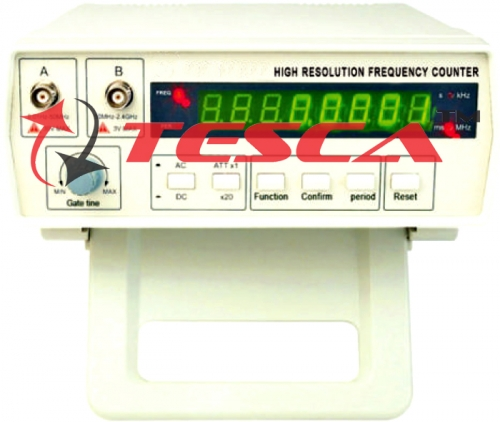
A frequency counter, also popularly known as a frequency meter, is an instrument that helps measure the time of reputed digital signals and the frequency correctly and associates with a wide range of radio frequencies.
It displays the frequency of analog and digital signals in Hz.
In simple words, these are essential instruments that count the number of cycles per second of an input signal.
These are widely used in electronics and telecommunication industries to measure frequency, bandwidth, peak-to-peak voltage, or current or rise time.
A frequency counter uses Prescaler that eventually reduces the frequency, which is further helpful in operating the Digital circuit.
Frequency counters count the pulses and transfers them into the frequency counter when the number of pulses or events occurs in a period and displays it on the frequency range of vibrations.
The counter then sets to zero. Frequency counters are often found in-built into other devices, such as radio receivers, radar sets, and test equipment. It is a device that is easy to use, measures the frequency accurately, and displays it digitally.
How Does a Frequency Counter Work?
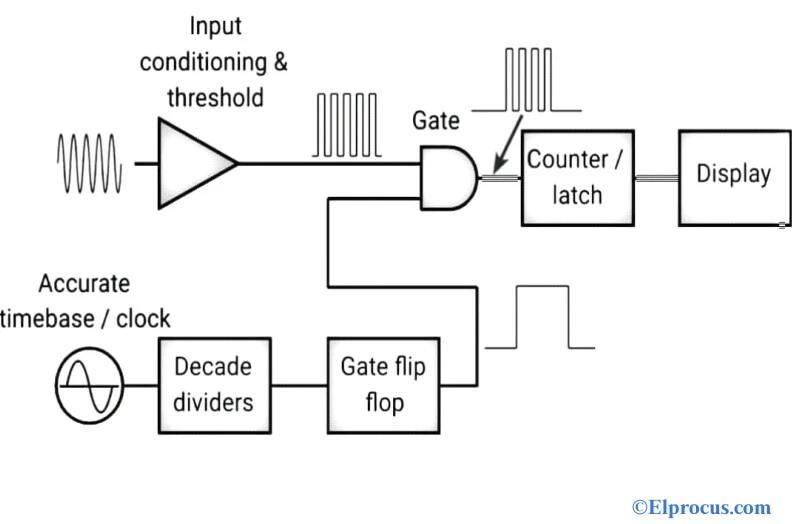
Image Source: Elprocus.com
A frequency counter measures a signal in the first split into the pulse setting. It operates by counting the number of times the signal passes through the voltage point to a trigger point in a duration.
The trigger of frequency counters starts at zero crossing point automatically. It is a device that sets in a clock speed with pulse per unit cycle and the pulses present send to the device for a limited time.
After this, vibrations/Pulses apply in a definite interval of time, counts the Pulses.
An electric counter does the whole process, and the pulses are sent to the cycle to represent the unidentified Signal and give it a value.
The frequency counter works on two modes to generate the pulses and time delay.
When we talk about the working of the frequency counter, then the pulse in this device generates from the wave generator and microcontrollers. The timer in this device figures as a counter.
It sets the count of the Pulses from high and low. The final count of the pulses takes place. It later collects in timer one, and it denotes the frequency of the vibrations by calculating it.
The device that converts the resultant value by multiplying it by ten frequency cycles per second converts the value of the pulses in Hz. After the whole calculation inside the frequency counter, the frequency of the pulses becomes visible on the LCD or LED.
Block Diagram of Frequency Counter?
Now let us focus on the block diagram of the frequency counter. It contains flip flop, gate, threshold, signal, input conditioning, display, accurate time base, Clock, Latch, and decade dividers.
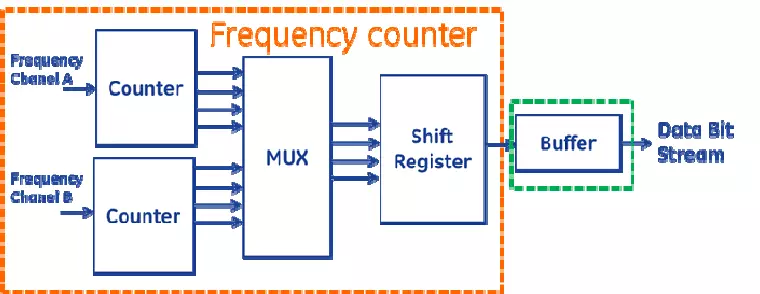
Frequency Counters Block Diagram, image source:researchgate.net
Input:
When the frequency counter, application of low output impedance, and high out in impedance of the input signal takes place, it will convert the signal into a rectangular or square wave by amplifying it to process in the Digital circuit.
The input in the device signal then buffers and amplifiers. It takes place with the help of the input condition and thresholds inside the counter.
At this stage, to control the counting of the additional pulses that may occur with noise at the edges, the Schmitt Trigger is used.
Clock:
Also known as an accurate time base, the Clock is an integral part of the block diagram, which helps reduce the various timing signals at time intervals. The Clock denotes and controls the timing signals with the help of a crystal oscillator, and then it further applies to decade dividers.
Flip Flop and Decade Dividers:
The incoming and Clock signals generate pulses that are fat to the decay dividers to divide the clock signals. After splitting the signals, the output of the movement then shows in the flip flop. It then produces the enabling Pulse for the main AND Gate.
Gate:
After the flip flop produces the pulse and enables accurate pulses, the input generated is applied to the Gate to create a series of pulses denoting the time interval precisely. If the input signal is at 1 Hz, the Gate may open, producing 1 million pulses as output signals.
Latch or Counter:
After the Gate generates the output, it feds to the frequency counter to count the occurring number of pulses from the input signal, the Latch holds the movement while displaying the figures.
The counter, on the other hand, measures the Pulses. Overall, the counter and the Latch hold the Pulses for about ten stages.
Display:
The Ledge and counter provide the output that the display delivers in the readable format. The frequency of the signal is then visible in LED or LCD. All the information related to the decade counter and other related details become visible on display.
Frequency Counter Circuit Operating Principle:
Let us know briefly about the frequency counter circuit operating principle. When the device and rates pulses from the square wave generator, these pulses are fed to the timer. The Pulses provided to the timer are then operated into different modes to generate time delay and count the pulses.
The timer then counts the number of pulses at a time interval from the input signal. The calculated Pulses provides the output to the LCD or LED display displays the signal’s frequency at a particular time interval in Hz.
Types of Frequency Counters:
Let us know more about the types of Frequency counters here:
1. Bench Frequency Counter:
Bench Frequency Counter is a type of device that is useful in applying electronic test equipment. It helps measure the period and equal frequency precisely.
Bench frequency counter counts CPU signals, and it also provides a constant compensation for temperature change.
The device is also known for reducing measurement errors that generally happen due to temperature drift. It is also helpful in measuring the frequency of a Periodic electrical signal, and these devices are beneficial for electronic labs and electronic projects.
2. PXI Frequency Counter:
A PXI frequency counter is helpful in the control system and track system for tests. It is a valuable device in measuring the frequency and phase of an input signal as per the reference signal.
Its application is mainly in audio, video, and RF signal. This type of frequency counter is known for implementing standalone devices or integration with other instruments such as spectrum analyzers and Oscilloscopes. Some of the different application of this device is testing microwave circuit, wireless devices, and Antennas.
3. Handheld Frequency Counter:
A handheld frequency counter helps measure the frequency of cycles per second of a Periodic waveform in the signal. Along with that, it also measures the period and time interval between two events in the waveform.
It provides precise measurement and output. The application of this device helps measure the radio frequencies or any other repeating signal such as audio signals, clock frequency, etc. It represents the cycle per unit number in Hz.
4. Panel Meter:
A panel meter is a type of frequency counter available in panel mount mode. It has application in determining the frequency of audio and radio signals.
It helps incorporate items with different kinds of equipment to count the time intervals and frequency.
Compared to the other types of frequency count, two parameters are cheaper and valuable for measuring the frequency of a signal in Hz.
How to count intervals in Frequency Counters?
The term “frequency counter” may also apply to devices that measure period or frequency directly, without distinguishing between positive and negative frequencies.
Every frequency counter has a clock signal. The signal in the device feeds to a divider circuit. It divides the clock signal down to a low frequency for use by the rest of the counter.
The output of this divider collects in the drive a flip-flop that counts the frequency intervals between the falling edges of the input clock signal. It is essential to select the time base interval in the frequency counter when calculating the time interval. The option that is displayed is 0.1 seconds, 1 second, 10 seconds.
It refers to the length of time to count the incoming pulses. It is an effective tool for measuring alternating current (AC) and direct current (DC).
Buying Guide: What to Consider When Choosing Frequency Counter?
Now that you are looking forward to purchasing a frequency counter, you need to understand that there are some points and features that you should keep in mind before buying any frequency counter.
Some of the features that you should look at are:
1. Type of frequency counter:
When we talk about frequency count, many types of frequency counters can help you do your job. But not every frequency counter is best for you. There is an additional frequency counter, and apart from that, the most suitable for you may be the handheld alternatives.
The reason behind the choice is that handheld models are smaller and convenient, so they can make your job easier as you can carry and operate these devices anywhere.
However, you should remember that the handheld device is less powerful than the Classic frequency counters, so you should figure out which one is best for your purpose before buying the frequency counter.
2. The range of frequency:
Today, different kinds of Frequency Counter are available in the market, and these counters differ in range. It depends on you which for you for the task you want to complete using the frequency counter. Frequency counters offer a reach up to 2.4 GHz from brand to brand and product to product.
3. Screen:
Every product has a different type of screen, and you should consider purchasing a frequency counter that makes it easy for you to read the frequency.
Counters that have a backlit background make it easier and convenient for you to read the frequency.
4. User-friendly:
No matter what kind of device you are purchasing, it can be a hassle if it is not easy for you to use. Generally, the frequency counter is easy to use, but it depends upon the model operators, which sometimes becomes tricky if it doesn’t have any proper instruction for the user.
Buying frequency counter, you should go for a model that is easy to understand regarding attenuators, knobs, and Panels.
5. Assembly kits:
You may get the already assembled frequency counter or kit to build one when you go for any frequency counter. If you want to develop the Frequency Counter, then you can go for the Assembly kits. Otherwise, you can opt for an assembled one.
6. Functions:
The most important that you should keep in mind before buying the frequency counter is to go for a frequency counter with different functions such as voltage reading. Do your research for a device that offers more function to help you provide all the tools you need to make any measurements.
Best Frequency Counters: Tesca Global Frequency Counters
Are you searching through the internet and looking for the best frequency counters? If yes, then Tesca Global frequency counters are here for your rescue. We are here to let you know about the best Frequency counter:
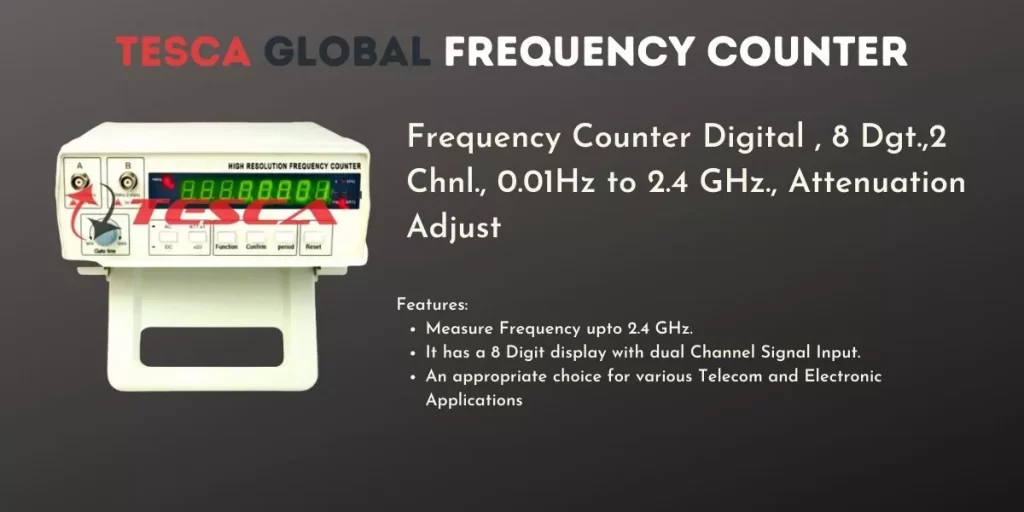
Frequency Counter Digital: 8 Digital, 2Chnl., 0.01Hz to 2.4 GHz., Attention Adjust
At Tesca, we are here offering your frequency counter that measures frequency up to 2.4 GHz. It is a robust device with an eight-digit display and dual-channel signal input. The device which we offer here is the right choice for various electronic and Telecom applications. So, order it now to add more to your workplace.
Conclusion
Now that you have gone through the article, we hope you know what the frequency counter can do and how it can help you add more to your workspace. To conclude, it is right to say that the frequency counter is one of the most valuable instruments.
Before buying the frequency count, you should consider the point such as the function of its counter, the frequency range, and the type of frequency counter you need. Remember the vital points in your mind before buying any frequency counter and choose the right one for you as per your preference and requirement.
FAQs:
What are Frequency Counters used for?
A frequency counter is a device used for counting the number of times that electromagnetic waves pass through any given point in space per unit time. A frequency counter is a device that displays the number of cycles of a repetitive phenomenon per unit of time.
What are the types of Frequency Counter?
There are five types of frequency counters. They are:
Bench frequency counter
PXI frequency counter
Handheld frequency counter
Panel meter
What is the unit of frequency?
The unit of the frequency counter is Hz. It measures the signal in Hertz
What is the use of a Frequency Counter?
A frequency counter helps measure electrical frequencies or mechanical vibrations. It allows the transmission frequency to evaluate and the rate at which it is changing.
What type of counters helps measure high frequencies?
There are two types of counters that you can use to measure the high frequencies. They are synchronous and asynchronous counters.
How do you find the frequency of a counter?
We can use the standard counting method to find out the frequency of the counter. It measures the frequency of a motion by counting the number of cycles per second. It also displays this information as a function of time or amplitude. We can find the measurement signal into the counter shape and set it to a time interval. The counter value thus becomes the frequency measurement as:
f= time= counter value= counter value in Hz
What is the Frequency Counter pattern?
The frequency counter has a frequency pattern that uses an object or selects it to collect the values. It also organizes the frequency of the chosen values. It uses a design in an array or a string that helps in avoiding the nested loops.
What do you mean by the mod counter?
A mod counter is the number of states that the frequency counter counts. The other popular word for Mod counter is modulus counter that counts the pulse sequence with the application of a clock signal.



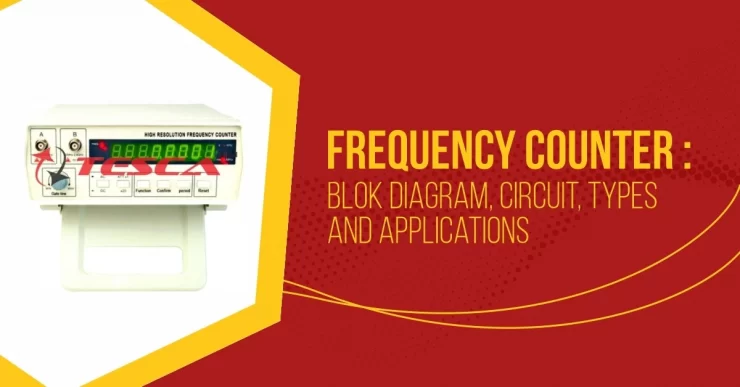

Add comment